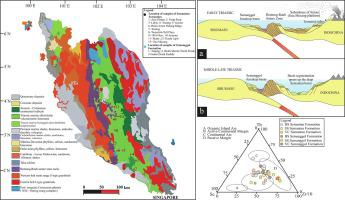当前位置:
X-MOL 学术
›
J. Asian Earth Sci.
›
论文详情
Our official English website, www.x-mol.net, welcomes your feedback! (Note: you will need to create a separate account there.)
Mineralogical and geochemical imprints to determine the provenance, depositional history and tectonic settings of Triassic turbidites in the Semanggol and Semantan Basins, Peninsular Malaysia
Journal of Asian Earth Sciences ( IF 3 ) Pub Date : 2020-11-01 , DOI: 10.1016/j.jseaes.2020.104539 Zulqarnain Sajid , Mohd Suhaili Ismail , Tanzila Hanif
Journal of Asian Earth Sciences ( IF 3 ) Pub Date : 2020-11-01 , DOI: 10.1016/j.jseaes.2020.104539 Zulqarnain Sajid , Mohd Suhaili Ismail , Tanzila Hanif

|
Abstract The present study provides systematic mineralogical, inorganic geochemical and Rock-Eval analyses of turbidite deposits of the Semanggol and Semantan formations to investigate their provenance, depositional environment and tectonic setting as well as type, origin and maturation of organic matter in black shale. These deposits are extensively distributed in Peninsular Malaysia and are observed in the field as conglomerate, pebbly sandstone, thick-bedded sandstone, interbedded sandstone and shale, laminated black shale, and tuffaceous sandstone. These sedimentary sequences are predominantly deep-marine and occasional shallow-marine deposits characterizing a deep-marine fan system. Based on Al2O3/TiO2 ratios, more felsic rocks for the Semanggol Formation and felsic-intermediate rocks for the Semantan Formation are proposed as sources for their detrital fractions and this interpretation is also substantiated by the binary plot of Zr vs Ti. V/(V + Ni), V/Ni and Ni/Co analyses indicate anoxic/oxic conditions. Ternary diagram of immobile- trace-elements inferred passive margin for Semanggol turbidites and an active-continental margin for Semantan turbidites. The dissimilarity between geochemically and geologically derived tectonic settings, mainly for the Semanggol turbidites, is because of changing tectonic setting and recycled nature of sediment sources that were deposited in diverse tectonic settings. The black shale clay fractions from both formations dominantly contain illite and kaolininte with abundant traces of quartz. The illite content varies from 43 to 56% and illite crystallinity index (IC) from 0.2° to 0.4° Δ2θ (average: 0.28° Δ2θ), showing studied black shale fall in anchizone. Rock-Eval pyrolysis reveals Type-III kerogens, suggesting a terrestrial source of organic matter in black shale of both formations.
中文翻译:

确定马来西亚半岛 Semanggol 和 Semantan 盆地三叠纪浊积岩的来源、沉积历史和构造环境的矿物学和地球化学印记
摘要 本研究对 Semanggol 和 Semantan 地层的浊积岩矿床进行了系统的矿物学、无机地球化学和岩石评价分析,以研究它们的来源、沉积环境和构造环境以及黑色页岩中有机质的类型、成因和成熟度。这些矿床广泛分布在马来西亚半岛,在现场观察到的为砾岩、卵石砂岩、厚层砂岩、砂岩和页岩互层、黑色层状页岩和凝灰质砂岩。这些沉积层序以深海扇系统为特征,主要是深海和偶尔的浅海沉积物。基于 Al2O3/TiO2 比率,Semanggol 组的更多长英质岩石和 Semantan 组的长英质-中质岩石被提议作为其碎屑部分的来源,这种解释也得到了 Zr 与 Ti 的二元图的证实。V/(V + Ni)、V/Ni 和 Ni/Co 分析表明缺氧/好氧条件。固定微量元素三元图推断 Semanggol 浊积岩的被动边缘和 Semantan 浊积岩的活动大陆边缘。地球化学和地质衍生的构造环境之间的不同,主要是对于 Semanggol 浊积岩,是因为不断变化的构造环境和沉积在不同构造环境中的沉积物源的循环性质。两种地层的黑色页岩粘土成分主要含有伊利石和高岭土,并含有大量石英。伊利石含量从 43% 到 56% 不等,伊利石结晶度指数 (IC) 从 0.2° 到 0.4° Δ2θ(平均:0.28° Δ2θ),表明研究的黑页岩落入 anchizone。Rock-Eval 热解揭示了 III 型干酪根,表明两种地层的黑色页岩中都有有机物质的陆地来源。
更新日期:2020-11-01
中文翻译:

确定马来西亚半岛 Semanggol 和 Semantan 盆地三叠纪浊积岩的来源、沉积历史和构造环境的矿物学和地球化学印记
摘要 本研究对 Semanggol 和 Semantan 地层的浊积岩矿床进行了系统的矿物学、无机地球化学和岩石评价分析,以研究它们的来源、沉积环境和构造环境以及黑色页岩中有机质的类型、成因和成熟度。这些矿床广泛分布在马来西亚半岛,在现场观察到的为砾岩、卵石砂岩、厚层砂岩、砂岩和页岩互层、黑色层状页岩和凝灰质砂岩。这些沉积层序以深海扇系统为特征,主要是深海和偶尔的浅海沉积物。基于 Al2O3/TiO2 比率,Semanggol 组的更多长英质岩石和 Semantan 组的长英质-中质岩石被提议作为其碎屑部分的来源,这种解释也得到了 Zr 与 Ti 的二元图的证实。V/(V + Ni)、V/Ni 和 Ni/Co 分析表明缺氧/好氧条件。固定微量元素三元图推断 Semanggol 浊积岩的被动边缘和 Semantan 浊积岩的活动大陆边缘。地球化学和地质衍生的构造环境之间的不同,主要是对于 Semanggol 浊积岩,是因为不断变化的构造环境和沉积在不同构造环境中的沉积物源的循环性质。两种地层的黑色页岩粘土成分主要含有伊利石和高岭土,并含有大量石英。伊利石含量从 43% 到 56% 不等,伊利石结晶度指数 (IC) 从 0.2° 到 0.4° Δ2θ(平均:0.28° Δ2θ),表明研究的黑页岩落入 anchizone。Rock-Eval 热解揭示了 III 型干酪根,表明两种地层的黑色页岩中都有有机物质的陆地来源。


























 京公网安备 11010802027423号
京公网安备 11010802027423号